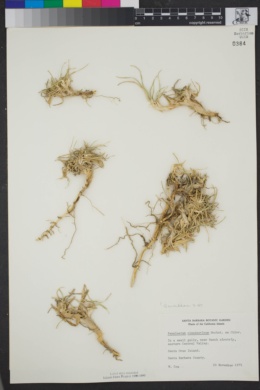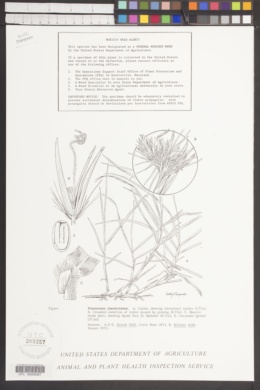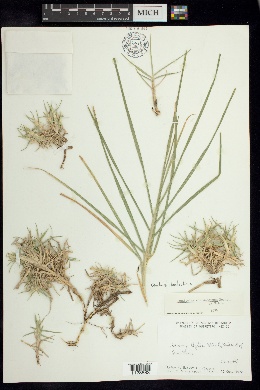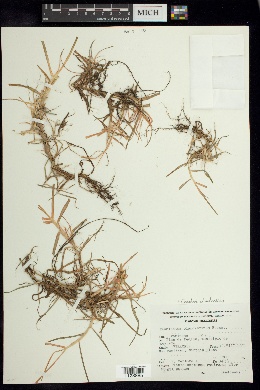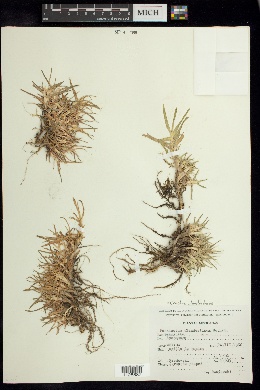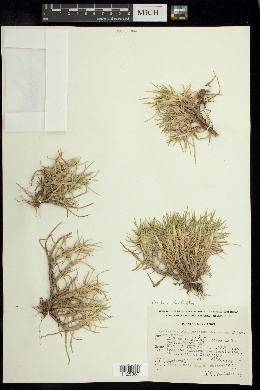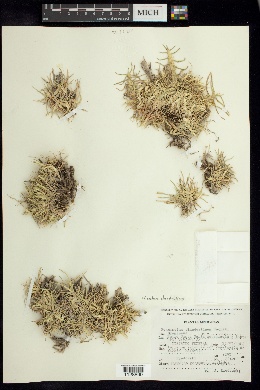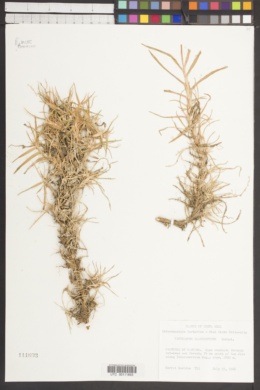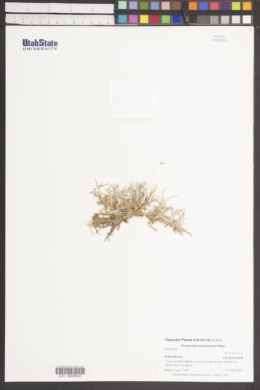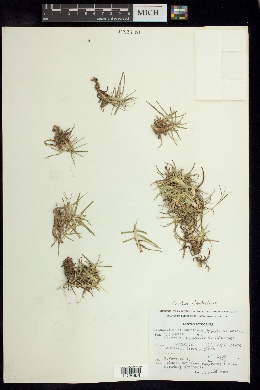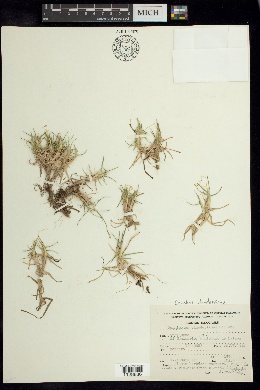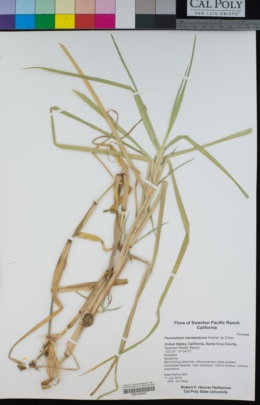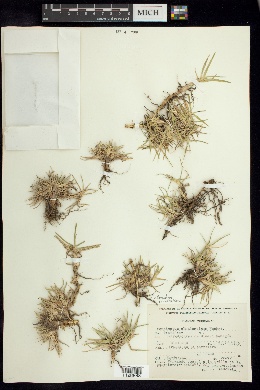Pennisetum clandestinum
|
|
|
|
Family: Poaceae
kikuyugrass, more...Kikuyu grass, Kikiyu Grass
|
Plants perennial; rhizomatous and stoloniferous. Culms 3-45 cm, decumbent, highly branching; nodes glabrous. Sheaths glabrous or pubescent; ligules 1.3-2.2 mm; blades 1-15 cm long, 1-6 mm wide, flat or folded, glabrous or pubescent. Panicles 2-2.7 cm, axillary, concealed in the sheaths; rachises flat, glabrous or scabrous. Fascicles 1-6; axes to 0.5 mm, with 1-2 spikelets; outer and inner bristles alike, 6-15, 0.5-10.9 mm; primary bristles 10-14 mm, usually not noticeably longer than the other bristles. Spikelets 10-22 mm, sessile or pedicellate, pedicels to 0.2 mm; lower glumes usually absent, sometimes to 0.5 mm, veinless; upper glumes 0-1.3(3.5) mm, veinless; lower florets sterile; lower lemmas 10-22 mm, 9-13-veined; lower paleas usually absent; upper lemmas 10-22 mm, 8-12-veined; upper paleas 2-7-veined; anthers 4.7-7 mm, long-exserted from the florets at anthesis. 2n = 36. Pennisetum clandestinum is native to Africa. It now grows in many parts of the world, often as a forage or lawn grass. The U.S. Department of Agriculture considers it a noxious weed. In parts of the Flora region, it is well-established in lawns. Scholz (2006; Feddes Repertorium 117: 513) recommended treating P. clandestinum as the only species in a new genus Kikuyuochloa as K. clandestina because of its great morphological different from other members of the tribe. Recent phylogenetic work shows it to be embedded in Pennisetum (Donadío, S., Giussani, L.M., Kellogg, E.A., F.O. Zuloaga & O. Morrone. In press. A molecular phylogeny of Pennisetum and Cenchrus (Poaceae-Paniceae) based on the trnL-F, rpl16 chloroplast markers. Taxon) and, consequently, it is being left in Pennisetum in this treatment. [I thank Drs. E.A. Kellogg and F. Zuolaga for sharing the information about the forthcoming paper with me ahead of publication]. Plants perennial; sometimes rhizomatous. Culms 2-8 m, erect, pubescent beneath the panicle; nodes glabrous or pubescent. Sheaths glabrous or pubescent; ligules 1.5-5 mm; blades 23-125 cm long, (4)12-40 mm wide, flat, glabrous or pubescent. Panicles terminal, 8-30.5 cm long, (10)30-50 mm wide, fully exerted from the leaf sheaths, erect, golden-yellow to dark purple; rachises terete, pubescent. Fascicles 30-40 per cm, disarticulating at maturity; fascicle axes 0.5-1.5 mm, with 1-5 spikelets; outer bristles 20-63, 1.5-10.3 mm, yellow or purple, scabrous; inner bristles 4-6, 9.1-11.5 mm, yellow or purple, sparsely long-ciliate; primary bristles 13-40 mm, noticeably longer than the other bristles, yellow or purple, scabrous. Spikelets 5.9-7 mm, pedicellate; pedicels of terminal spikelets 0.2-0.4 mm, of other spikelets 1.8-3 mm; lower glumes absent or to 0.8 mm; upper glumes 0.8-3 mm, 0-1-veined; lower florets sterile or staminate; lower lemmas 4-5.3 mm, 3-5(6)-veined; lower paleas 4-4.7 mm; anthers absent or 2.2-3.1 mm, penicillate; upper lemmas 4.5-7 mm, subcoriaceous, shiny, 5-7-veined, acuminate; anthers 2.7-3.6 mm, penicillate. Caryopses 1.8-2.2 mm. 2n = 28. Pennisetum purpureum is native to Africa but now grows in tropical areas throughout the world, frequently becoming naturalized. It is grown as an ornamental in the Flora region, and, less commonly, as forage. |



































